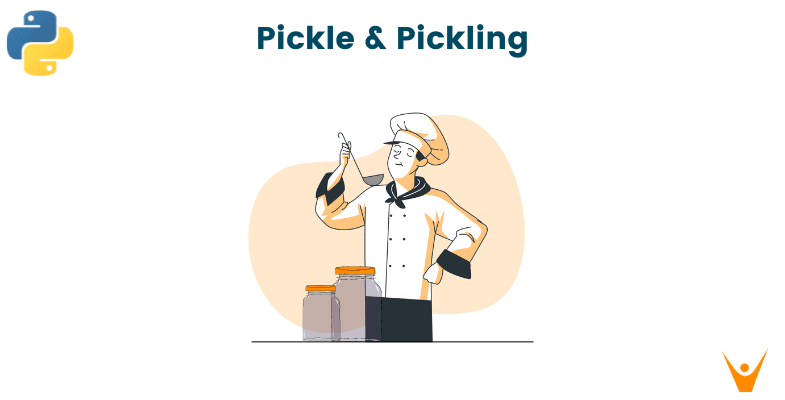As we know python is an object-oriented programming language, which allows you to write code at a high level of abstraction. An important aspect of this is pickling which is used to remember the state of an object. let's learn what is pickle in python and how to use it with code.
But first, we need to revise some basic Object concepts.
What is an Object in python?
Objects in python are instances of classes that inherit the class's attributes and methods. It is a virtual representation of a physical entity that encapsulates its behavior and state. Everything in Python is an object, including integers, strings, lists, functions, and so on.
These objects can be manipulated by invoking methods and accessing class-defined attributes. This enables the three core principles of object-oriented programming: encapsulation, inheritance, and polymorphism. Using these concepts, you can design more organized and reusable code that is easier to maintain and debug.
Also, learn how to check an object's type in python.
What is Pickle in python?
Pickle is a standard Python library for serializing and deserializing Python objects to and from binary data streams. This enables you to save complex data structures like lists, dictionaries, and custom classes to a file or send them over the network to another program. It is a powerful feature that allows you to save a program's state and resume it later.
So, pickling refers to the process of serializing an object, and unpickling refers to the process of deserializing an object. Pickling an object produces a stream of bytes that can be saved to a disc, transmitted over a network, or stored in memory. Unpickling converts the stream of bytes back to the original object.
It is important to note that the pickled data is not human-readable and can only be read by another python program. As a result, it cannot be used to store data in a human-readable format.
Furthermore, the data produced by pickling is version-specific, and objects pickled in one version of Python may not be compatible with another.
Why it is called so?
The name "pickle" comes from the concept of "pickling" in cooking, which refers to the process of preserving food by storing it in a container. In the same way, the Python pickle module preserves and stores objects by converting them into a byte stream.
What is serializing?
In Python, serializing an object means converting it into a binary data stream that can be stored or transmitted over a network. Deserialization is the process of converting an object back to its original form. As we mentioned, python's pickle module allows you to serialize and deserialize objects, allowing you to save complex data structures to a file or send them over a network.
How to do Pickling in python?
Pickle provides two methods for serializing and deserializing objects: pickle.dump and pickle.load. The pickle.dump method serializes an object and writes it to a file-like object, while the pickle.load method reads serialized data from a file-like object and deserializes it back into the original object.
Let's see how to use Python's pickle module to pickle and unpickle objects.
Pickling an object: To pickle an object, you need to call the pickle.dump method, passing the object and the file object to be written to. For example:
import pickle data = {'a': [1, 2.0, 3, 4+6j], 'b': ("character string", b"byte string"), 'c': {None, True, False}} with open('data.pickle', 'wb') as f: pickle.dump(data, f)
Unpickling an object: To unpickle an object, you need to call the pickle.load method, passing the file object to be read from. For example:
import pickle with open('data.pickle', 'rb') as f: data = pickle.load(f) print(data)
In addition to pickle.dump and pickle.load, the pickle module also provides the pickle.dumps and pickle.loads methods, which allow you to serialize and deserialize objects in memory, without the need for a file. For example:
import pickle data = {'a': [1, 2.0, 3, 4+6j], 'b': ("character string", b"byte string"), 'c': {None, True, False}} serialized_data = pickle.dumps(data) unpickled_data = pickle.loads(serialized_data) print(unpickled_data)
Should I use pickle or JSON?
Python's pickle and JSON modules both provide methods for serializing and deserializing Python objects, but there are some major differences that you must know about.
Pickle serializes objects that is is not human-readable, while The JSON module serializes objects in a human-readable text format. So, Pickle is Python-specific, which means that items pickled in Python can only be unpickled by another Python program, but JSON objects may be read by many computer languages, including Python, JavaScript, Ruby, and others.
Also, pickle is capable of serializing any object, including custom classes and complex data structures like lists, dictionaries, and sets. The JSON module, on the other hand, has some restrictions on the data structures it can serialize, such as the inability to serialize complex numbers or sets.
At last, talking about performance, the pickle module is faster because it serializes objects directly in binary format, and not like JSON, where it first serializes objects to a text format and then parses that text back into an object.
Conclusion
So now you have understood everything about the Python Pickle module and how it is used. It is a powerful tool for applications that require data storage between sessions or for long-running processes that require progress saving. But it should be used with caution because the data produced is not human-readable and may not be compatible with other versions of Python.








